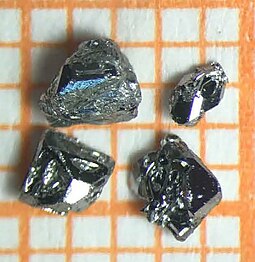Intermetallic compound
An intermetallic compound (more precisely intermetallic phase ) is a homogeneous chemical compound made up of two or more metals . In contrast to alloys , they show lattice structures that differ from those of the constituent metals. In their lattice there is a mixed bond consisting of a metallic bond component and smaller atomic bond or ion bond components, which results in superstructures . This also includes the so-called order phases, whose special lattice structure results from the order setting of the alloy atoms.
Structure and properties
There are intermetallic compounds with a stoichiometric composition according to the usual valencies of metals and there are intermetallic phases which have more or less extensive homogeneity areas in the phase diagram . A homogeneity range, also called phase width, specifies the limits between which the quantitative ratio of the various metals can vary.
Intermetallic connections are often hard (great hardness, brittleness, strength) and also very chemically resistant (corrosion resistance). They usually have a high melting point and their electrical resistance is usually an order of magnitude higher than that of pure transition metals. However, there are also compounds with semiconductor properties and some compounds are even characterized by special magnetic or superconducting properties.
The special physical and mechanical properties of such compounds result from the particularly strong bond between the dissimilar atoms, which is predominantly metallic with more or less large proportions of other types of bond ( ion , covalent bond ).
They thus occupy an intermediate position between metallic alloys and ceramics .
Manufacturing
Intermetallic phases are manufactured using both powder metallurgy and conventional melting processes, although their mechanical properties can make manufacturing and processing difficult.
Examples
Examples of intermetallic phases are:
- Laves phases
- Heusler phases
- Zintl phases
- Häggs phases (coordination phases like Fe 3 C - cementite)
- Hume-Rothery phases , which always have fixed valence electron concentrations
- Nitinol (NiTi) ( shape memory alloy )
- Samarium-Cobalt (SmCo 5 ) ( magnetic material )
- Nb 3 Sn ( superconductor )
- Ni 3 Al in nickel-based superalloys
- NiAl , TiCr 2 , TaFeAl (experimental high temperature materials)
- Magnesium silicide (Mg 2 Si),
- Titanium aluminides Ti 3 Al and TiAl (experimental high-temperature lightweight materials)
- Iron aluminides FeAl and Fe 3 Al
- FeCr, σ-phase in high-alloy chromium and chromium-nickel steels, can lead to undesired embrittlement and is therefore avoided by selecting the alloy composition
- so-called MAX layers, i.e. materials of stoichiometry M n + 1 AX n , which are composed of a transition metal M, a main group element (English A-group , usually III A or IV A ) and a carbon or nitrogen part X, such as TiSiC
Higher alloy bronze and brass alloys also consist of intermetallic phases, which, however, can arise in different forms with different mixing ratios (for example Cu 3 Sn and Cu 3 Sn 5 ). If the correct mixing ratio is not achieved exactly, classic alloys are formed, but from the various intermetallic phases that are closest to the mixing ratio.
use
Intermetallic compounds are used as high-melting, high-strength alloys, superconductors, permanent magnet materials, metallic glasses and the like. a. m. great technical importance. They also play a crucial role in the precipitation hardening of aluminum and nickel alloys and maraging steels .
See also
literature
- JH Westbrook, Robert L. Fleischer (Eds.): Intermetallic Compounds: Principles and Applications. 2 Volume Set: Principles / Practice v. 1 & 2 . John Wiley & Sons, 1994, ISBN 0-471-93453-4 .
- JH Westbrook, Robert L. Fleischer (Ed.): Intermetallic Compounds: Progress: 3 . John Wiley & Sons, Chichester 2002, ISBN 0-471-49315-5 .
- Gerhard Sauthoff : Intermetallics . Wiley-VCH, 1995, ISBN 3-527-29320-5 .
- Gerhard Sauthoff: Intermetallics . In: Ullmann's Encyclopedia of Industrial Chemistry . Wiley-Vch, 2005, ISBN 3-527-31097-5 , pp. 1-32 , doi : 10.1002 / 14356007.e14_e01.pub2 .
- Gerhard Sauthoff: Intermetallic Materials . In: Landolt-Börnstein (New Series) Group VIII: Advanced Materials and Technologies, Subvolume VIII / 2A: Powder Metallurgy Data, Part 2: Refractory, Hard and Intermetallic Materials . Springer-Verlag, 2002, ISBN 3-540-42961-1 , pp. 14-1-14-45 , doi : 10.1007 / 10858641_17 .
Web links
- Intermetallics (English trade journal)
Individual evidence
- ^ G. Sauthoff: Intermetallics: Characteristics, Problems and Prospects. In: Basics of Thermodynamics and Phase Transition in Complex Intermetallics (1st European School in Materials Science of the EU Network of Excellence "Complex Metallic Alloys" CMA), edited by E. Belin-Ferré, Singapore: World Scientific, 2008, p. 147 -188.
- ↑ https://www.mpie.de/3837955/12_volume_02-2018_intermetallics.pdf
- ↑ M. Pohl and O. Storz: Sigma-phase in duplex-stainless steels. Z.Metallk. 95 (7): 631-638, 2004.
- ↑ AF Padilha, W. Reick and FC Pimenta: A Comparative-Study on the Precipitation of the Sigma-Phase in a Superferritic and in a Duplex Stainless-Steel. Z.Metallk. 92 (4): 351-354, 2001.
- ↑ J. Alami, P. Eklund, J. Emmerlich, O. Wilhelmsson, U. Jansson, H. Högberg, L. Hultman, and U. Helmersson: High-power impulse magnetron sputtering of Ti – Si – C thin films from a Ti3SiC2 compound target . In: Elsevier BV (Ed.): Thin Solid Films . 515, No. 4, December 5, 2006, pp. 1731-1736. doi : 10.1016 / j.tsf.2006.06.015 .
